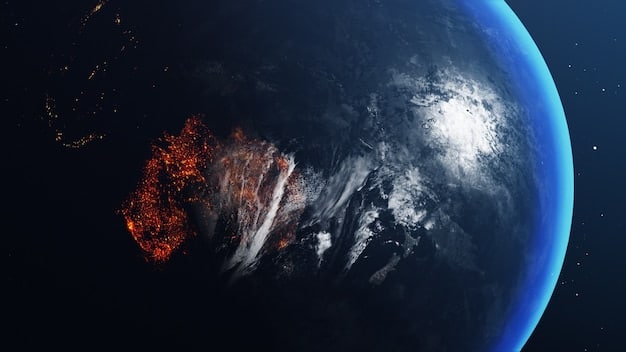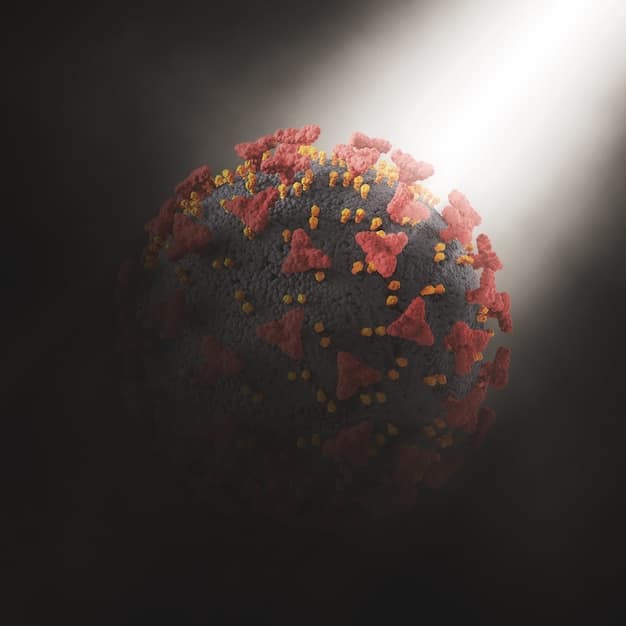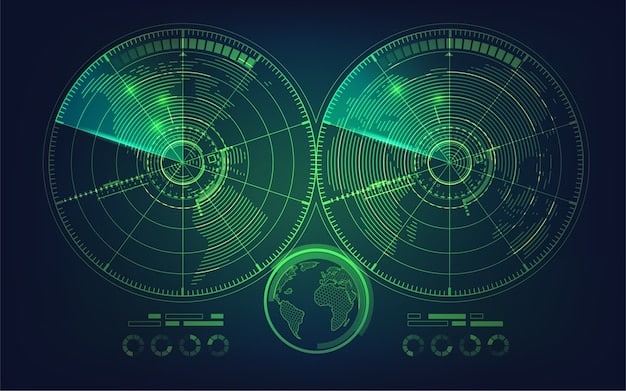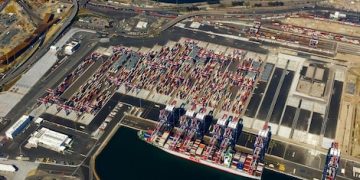US Efforts to Tackle Space Debris: A Growing Orbital Challenge

The US is addressing the growing problem of space debris in Earth’s orbit through a combination of tracking, mitigation strategies, international collaboration, and the development of active debris removal technologies.
The proliferation of space debris, or space junk, poses a significant threat to operational satellites, human spaceflight, and the future of space exploration. How is the US addressing the growing problem of space debris in Earth’s orbit? This article delves into the multifaceted approach the United States is taking to mitigate this escalating issue.
Understanding the Space Debris Problem
The issue of space debris is becoming increasingly critical as the amount of artificial objects orbiting Earth continues to grow. These objects, ranging from defunct satellites and rocket bodies to tiny fragments from collisions, pose a significant risk to active spacecraft. Understanding the scope and nature of this problem is the first step in addressing it.
What Constitutes Space Debris?
Space debris includes any non-functional, human-made object in orbit. These can be large, like entire satellites, or small, like paint flakes. The key is that they no longer serve a purpose but still orbit Earth, creating potential hazards.
Why is Space Debris a Problem?
The primary concern is the risk of collisions. Even small pieces of debris can cause significant damage to operational satellites due to the high speeds at which they travel. This can lead to loss of service, increased costs, and more debris, creating a cascading effect known as the Kessler Syndrome.

To mitigate these risks, various strategies are being implemented. This includes tracking debris, developing technologies to remove it, and establishing international guidelines for responsible space activities.
- Tracking and cataloging space debris
- Developing technologies for debris removal
- Establishing international guidelines for space activities
Space debris poses a multifaceted threat. This requires an aggressive tracking system to monitor existing debris, mitigation strategies to prevent future debris creation, and active debris removal technologies to clear the orbital environment.
US Space Surveillance and Tracking Efforts
A critical component of the US approach to space debris management is the ability to track and catalog objects in orbit. This allows for collision avoidance maneuvers and a greater understanding of the debris environment. US Space Surveillance Network (SSN) uses a global network of sensors to monitor objects in space.
The Role of the Space Surveillance Network (SSN)
The SSN is a network of ground-based radars and optical sensors that track objects in Earth orbit. It is operated by the US Space Force and provides data used for collision avoidance and space situational awareness.
Capabilities and Limitations
The SSN can track objects as small as 10 cm in diameter in low Earth orbit (LEO). The effectiveness of the SSN is crucial for identifying potential threats. Its limitations include challenges in tracking smaller objects and reliance on ground-based sensors, which can be affected by weather conditions.
By continuously improving its tracking capabilities, the U.S. aims to enhance space safety and protect valuable assets in orbit. This involves significant upgrades to radar systems and the integration of data from multiple sources.

- Upgrading radar systems for better tracking
- Integrating data from multiple sources
- Enhancing space situational awareness
Space tracking is an evolving field, with continuous improvements in technology and techniques. These efforts ensure that the US can effectively monitor and manage the threat posed by space debris.
Mitigation Strategies and Guidelines
Preventing the creation of new space debris is a primary focus of US efforts. Mitigation strategies aim to minimize the amount of debris generated during space missions and ensure the responsible use of orbital resources.
The US Government Orbital Debris Mitigation Standard Practices
The US Government Orbital Debris Mitigation Standard Practices provide guidelines for government and commercial space operators to minimize debris creation. They cover aspects such as spacecraft disposal, minimizing debris release, and collision avoidance.
International Collaboration and Standards
International collaboration is essential for effective debris mitigation. The US works with other spacefaring nations through organizations. Working with others helps promote common standards and best practices.
The US guidelines emphasize the importance of designing spacecraft and missions with debris mitigation in mind. This includes features such as propulsion systems for controlled re-entry and passivation techniques to remove stored energy from defunct spacecraft.
- Designing spacecraft with controlled re-entry capabilities
- Using passivation techniques to remove stored energy
- Implementing collision avoidance maneuvers
While mitigation strategies are crucial, they are not enough to solve the existing debris problem. Active debris removal technologies are also necessary to clear the orbital environment.
Active Debris Removal Technologies
Active debris removal (ADR) involves developing and deploying technologies to remove existing space debris from orbit. These technologies are in the early stages of development. They hold promise for a more sustainable space environment.
Various ADR Methods Being Explored
Several ADR methods are being explored, including using robotic arms to capture debris, nets to ensnare objects, and lasers to deorbit debris. Each method has its advantages and challenges, and the optimal approach may vary depending on the target debris and orbital environment.
Challenges and Potential Solutions
One of the main challenges in ADR is the high cost and technical complexity of these missions. Other challenges include the need for precise navigation and control, as well as the potential for creating more debris during the removal process. Solutions involve developing more efficient and reliable technologies, such as drones and reusable spacecraft.
The US is investing in research and development of ADR technologies through various government agencies and private companies. These investments are crucial for advancing the state-of-the-art and demonstrating the feasibility of ADR missions.
- Investing in ADR research and development
- Developing efficient and reliable technologies
- Demonstrating the feasibility of ADR missions
The development of active debris removal technologies represents a critical step towards ensuring the long-term sustainability of space activities and protecting valuable assets in orbit.
International Cooperation
The problem of space debris is a global issue that requires international cooperation. The US is actively involved in various international forums and initiatives to promote responsible space behavior and coordinate debris mitigation efforts.
US Involvement in International Forums
The US participates in the UN Committee on the Peaceful Uses of Outer Space (COPUOS) and the Inter-Agency Space Debris Coordination Committee (IADC). It works with other nations to establish common standards and protocols for space activities.
Promoting Responsible Space Behavior
Promoting responsible space behavior involves encouraging all spacefaring nations to adhere to debris mitigation guidelines. It also encourages nations to share data and information about space debris and collaborate on debris removal efforts.
The US recognizes the importance of a coordinated international approach to space debris management. This includes sharing best practices, conducting joint research, and supporting international initiatives. It also involves improving the detection of debris.
- Sharing best practices for debris mitigation
- Conducting joint research on debris removal
- Supporting international initiatives for space sustainability
International cooperation is essential for ensuring a safe and sustainable space environment for all. This requires a commitment to responsible space activities and a willingness to work together to address the challenges posed by space debris.
Future Directions and Innovations
Addressing the growing problem of space debris requires continuous innovation and forward-thinking strategies. The US is exploring new technologies, policies, and approaches to enhance space sustainability and protect valuable orbital resources.
Innovations in Debris Tracking and Characterization
One area of innovation is improving debris tracking and characterization capabilities. This includes developing new sensors and algorithms to detect and track smaller pieces of debris, as well as better understanding the physical properties of debris objects. These advancements would improve accuracy.
Potential Policy Changes and Regulations
Potential policy changes and regulations could also play a role in addressing space debris. This includes implementing stricter debris mitigation standards for commercial space operators, creating incentives for responsible space behavior, and developing liability frameworks for collisions caused by debris.
The US is also investing in research and development of advanced technologies, such as autonomous spacecraft and artificial intelligence, to support debris removal and space traffic management. These technologies have the potential to offer more and more effective solutions for the challenging problem we have at hand.
- Investing in advanced technologies
- Implementing stricter debris mitigation standards
- Creating incentives for responsible space behavior
Looking ahead, the US is committed to staying at the forefront of space debris management. We will continue to explore innovative solutions that ensure the long-term sustainability and safety of space activities.
| Key Point | Brief Description |
|---|---|
| 🛰️ Space Surveillance | Tracking and cataloging debris to avoid collisions. |
| 🛡️ Mitigation Strategies | Reducing new debris creation through guidelines and standards. |
| ✨ Active Debris Removal | Developing technologies to remove existing debris from orbit. |
| 🤝 International Cooperation | Collaborating with other nations for responsible space behavior. |
Frequently Asked Questions
▼
Space debris refers to any non-functional, human-made object in orbit around Earth. It includes defunct satellites, rocket bodies, and fragments from collisions. These objects pose a threat to active spacecraft.
▼
Space debris poses a risk of collisions with operational satellites and spacecraft and human spaceflight. Even small pieces of debris can cause significant damage due to the high speeds at which they travel in orbit.
▼
The US tracks space debris through the Space Surveillance Network (SSN). SSN uses a global network of radars and optical sensors to monitor objects in Earth orbit, providing data for collision avoidance.
▼
Active debris removal (ADR) technologies are methods to remove existing space debris from orbit. Methods include robotic arms, nets, and lasers to capture or deorbit debris. ADR is a long and ongoing challenge.
▼
The US collaborates through the UN Committee on the Peaceful Uses of Outer Space (COPUOS) and the Inter-Agency Space Debris Coordination Committee (IADC). Collaboration fosters common standards and coordinated mitigation efforts.
Conclusion
The US is actively addressing the growing problem of space debris through comprehensive tracking, mitigation strategies, active removal technology, and international collaboration. These coordinated efforts will ensure the sustainability of the space environment for future generations.





